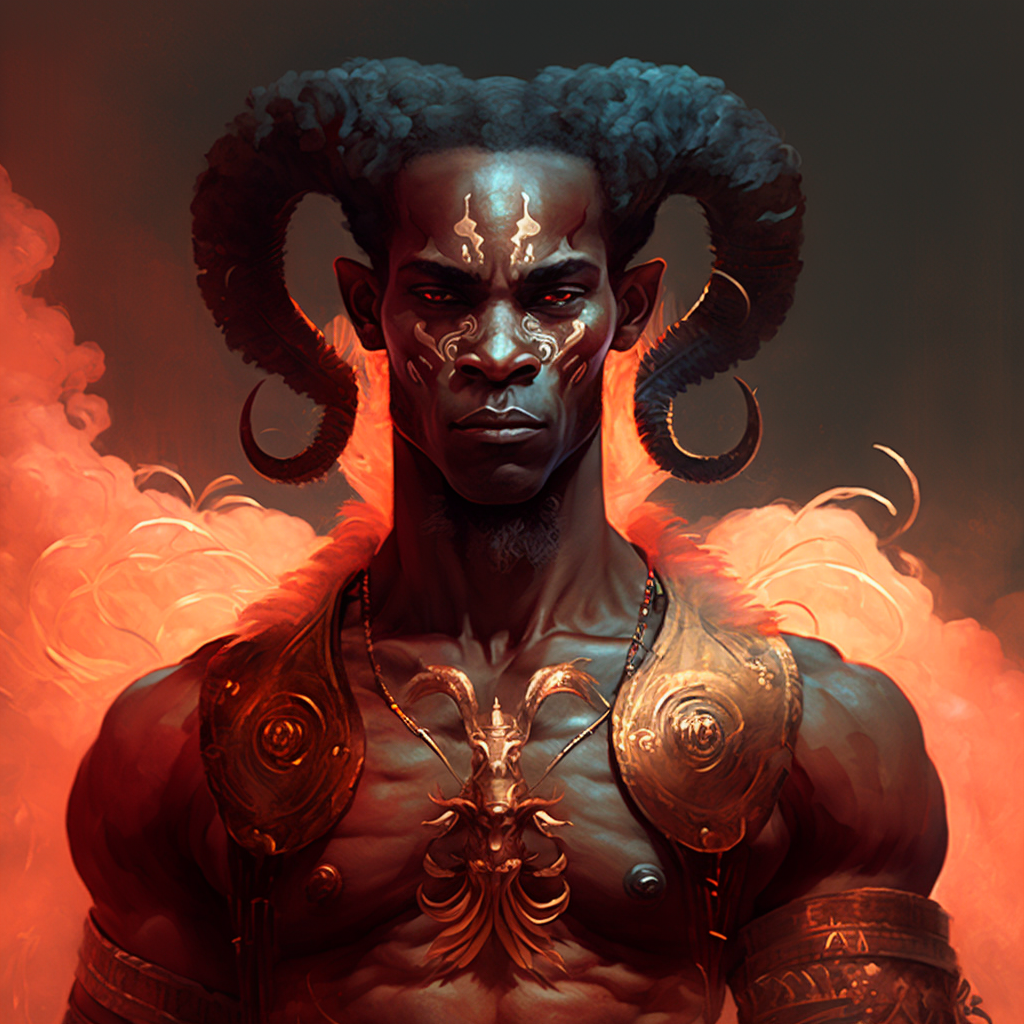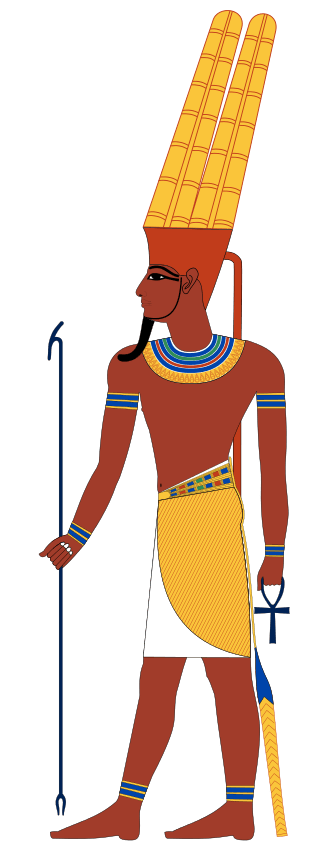Amun,”Amun-Ra (or Amun-Re), King of the Gods, Lord of the Thrones of the Two Lands”
Amun is an ancient Egyptian deity, known as the “King of the Gods,” associated with creation and fertility, often depicted with a ram’s head.

- Pantheon: Egyptian Pantheon
- Deity Title: Amun-Ra (or Amun-Re), King of the Gods, Lord of the Thrones of the Two Lands
- Deity Symbol: Amun is often depicted with a ram’s head, symbolizing his association with fertility, strength, and virility. He is also sometimes depicted holding a scepter or ankh, symbols of power and eternal life.
- Home Plane: Unknown, as Amun was believed to transcend the physical realm and exist in the realm of the gods.
- Deity Level: Greater deity
- Alignment: Lawful Neutral
- Aliases: Amun, Ammon, Ammon-Ra, Amen, Amon, Amoun
- Superior: None
- Traditional Allies: Ra, Ptah, Khnum
- Traditional Foes: Apophis, Set
- Divine Artifact: None
- Servants: Amun had a large and powerful following of priests and priestesses who served him in his temples and performed rituals and sacrifices on his behalf.
- Servitor Creatures: None specified in mythology.
- Sacred Animal: The ram
- Manifestations: Amun was believed to be capable of taking on various forms and appearing in dreams and visions. He was associated with the sun, wind, and air, and his manifestations were often accompanied by these elements.
- Signs of Favor: Followers of Amun believed that he showed favor through abundant crops, prosperity, and protection from harm. Dreams and visions were also seen as signs of Amun’s favor.
- Worshipers: Amun is worshipped by the ruling classes of ancient Egypt, as well as by common people seeking his protection and guidance. His temples were some of the largest and most elaborate in ancient Egypt.
- Cleric Alignments: Lawful Neutral, Lawful Good, Neutral
- Specialty Priests: Amun’s specialty priests were known as Hem-netjer, and were responsible for performing daily rituals and maintaining his temples.
- Holy Days: The most important holy day of the year for Amun was the Opet Festival, which was celebrated in Thebes and involved a procession of the sacred barque carrying the image of Amun from his temple to the temple of Luxor.
- Portfolio: Creation, fertility, kingship, wind, air, hiddenness, protection
- Domains: Air, Creation, Earth, Law, Nobility, Protection
- Favored Weapon: Spear
- Favored Class: Cleric
- Favored Race: Humans
- Duties of the Priesthood: The duties of the Hem-netjer included maintaining the temple grounds, performing daily rituals and sacrifices, and interpreting dreams and visions.
- Major Cult/Temple Sites: The temple of Amun at Karnak was one of the largest and most important religious sites in ancient Egypt. Other major temples dedicated to Amun were located in Thebes, Luxor, and Memphis.
- Benefits: Followers of Amun believed that by worshipping him and performing the rituals and sacrifices required by his priesthood, they could gain his protection and favor. Amun was seen as a powerful and benevolent deity, capable of providing abundant crops, fertility, and prosperity to his followers. Additionally, those favored by Amun were believed to have access to his hidden knowledge and divine wisdom.
Amun is a fascinating character from ancient Egyptian mythology, revered as the most important deity in the New Kingdom period. As the “King of the Gods,” Amun is known for his association with creation and fertility, as well as for his powerful and mysterious nature.
Born from the primeval waters of Nun, Amun is said to have created himself, and is often depicted with a ram’s head, symbolizing his strength and vitality. As a god of fertility, Amun is closely associated with the annual flooding of the Nile river, which brought life-giving water to the parched land and allowed crops to grow.
Despite his many followers and devotees, Amun remains a somewhat enigmatic figure, with his motives and desires often shrouded in mystery. Some believe that Amun’s ultimate goal is to achieve a state of unity with all creation, and that his many manifestations and forms are simply different expressions of this unifying force.
As a character, he is both powerful and benevolent, but also unpredictable and capricious. He is often depicted as a just and fair ruler, but can also be wrathful and vengeful towards those who cross him. Despite his godlike status, he is often shown to be accessible to his followers, and is believed to hear and respond to their prayers and offerings.
Amun is typically depicted as a tall, regal figure with the head of a ram, adorned with a double plumed crown and a long, flowing beard. He is often shown wearing a tight-fitting, knee-length garment and a broad collar, with his muscular arms crossed over his chest. His skin is depicted as a warm, golden-brown hue, and his eyes are large and expressive, conveying both wisdom and power. Overall, he exudes an aura of strength and vitality, befitting his status as the “King of the Gods.”
Overall, he is a complex and fascinating figure in ancient Egyptian mythology, embodying the dual qualities of creation and destruction, fertility and chaos, order and unpredictability. Through his many forms and manifestations, Amun continues to inspire awe and wonder in those who seek to understand him.

The Lore of the Gods
Book 3 – The Egyptian GodsLead Designers Steven Creech and Kevin Ruesch Lead Editor Steven Schend Creative Director Jim Butler Art Director Todd Morasch Artwork Aaron D. Siddal
Amon
The Hidden One; God of the Sky; King of the Gods; The Creator of All Things
Alignment: Lawful Neutral
Domain: Air, Balance*, Sun, Wind*
Symbol: Goose, Ram
Sacred Animal: Goose, Ram
Traditional Allies: Auran creatures, Horus, Osiris, Ra
Traditional Foes: Aberrations, Set, undead
Divine Artifact: Kheperesh (The Blue Crown)
Favored Weapon: Mace
Favored Class: Cleric, Rogue
Favored Race: Elf, Human
Benefits: clerics and rogues who worship Amon gain a +2 inherent bonus to all saves against divine magic.
Regarded as the god of the sky and a sun god, Amon is also the patron deity for the city of Thebes while the priests of Hermopolis view him (and his consort Amenet) as a primordial creation-deity. The protector of any worshipper in need, he became ruler of this family of gods after he merged with the sun god Ra to become Amon-Ra.
Amon is often depicted in human form with blue skin and either the head of a bearded man or a ram’s head with curved horns. Alternatively, his forms also include a frog-headed man, a cobra-headed man, an ape, or a lion. He wears a crown composed of a modius surmounted by two tall feather plumes. Interestingly enough, even though his symbol is the goose or ram, he is never depicted as either.
His true appearance is beyond all mortal understanding. Amon is said to be ‘hidden of aspect, mysterious of form, and invisible yet omnipresent throughout the cosmos. He is also an invisible creative power which is the source of all life in heaven, and on the earth, and in the great deep, and in the Underworld, and which manifests under the form of Amon-Ra.
Artifacts that the Avatar may possess:
Kheperesh, the Blue Crown (of Amon)
This regal crown appears as a sky-blue modius etched with a rams horn design on the surface and surmounted by two large ostrich plumbs.
- Kheperesh, the Blue Crown has the following properties:
- The wearer gains a inherent +6 bonus to his Charisma score
- The wearer bears a glamour that causes all clothing worn to appear as the finest and richest quality.
- The crown casts a continual Emotion (friendship) spell in a 30ft. radius.
- The wearer may cast the following spells at will; detect thoughts, enthrall, see invisibility and tongues.
- Charm monster 5/day.
- Magic Circle Against Chaos/evil/good/law 5/day.
- Phantom steed 2/day.
- Eyebite 2/day.
- Geas/Quest 2/day.
All spells are equal in effect to those cast by a 20th level cleric.

 Buy me a coffee
Buy me a coffee